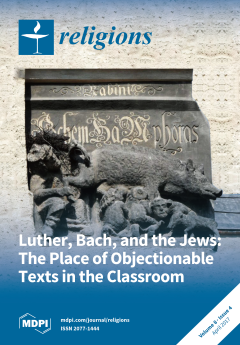At an annual American Academy of Religion conference thirty years ago, Robert Scharlemann presented a paper in which he compared and contrasted Barth and Tillich with reference to how they named God in their respective theologies. He suggested that the former labeled God
[...] Read more.
At an annual American Academy of Religion conference thirty years ago, Robert Scharlemann presented a paper in which he compared and contrasted Barth and Tillich with reference to how they named God in their respective theologies. He suggested that the former labeled God the “no to nothing,” while the latter symbolized God as the “nothing to know”—appellations out of which he formed his presentation title “The No to Nothing and the Nothing to Know: Barth and Tillich and the Possibility of Theological Science.” I have purloined Scharlemann’s title for my own essay, with the intent not only to maintain its theological implications but also to use it as a rubric for prosecuting the putative relationships that obtain among anticipation, nihilism, transcendence, mystery, and eschatology. If there are various species of transcendence, and if one can use and not merely mention the word “mystery” in some constative manner, then how may one speak of the actuality and potentiality of meaning? Is there a futurity to existential significance that empowers a life-affirming hope, which, in turn, embraces the inescapability of the “nothing” without plunging, or leaping, into the abyss of nihilism—the “no to nothing?” Alternatively, may one genuinely anticipate eschatological aspirations while remaining open to the enigma of the unprogrammable aleatoric “to come”—the “nothing to know?” Furthermore, how might one name “God” under either of these circumstances, even were one not to hold to any type of confessional theological ontology? Using John Caputo’s radical theology of the insistence of “God” as my Virgil (or Beatrice, which ever applies!) to guide us through the various paths one might take towards a genuine hope, I propose to investigate the plurivocity of discourses on meaning by inter-relating Caputo’s “nihilism of grace” with several supplementary works, including Ray Hart’s God Being Nothing, Amie Thomasson’s Fiction and Metaphysics, Stuart Kaufmann’s Humanity in a Creative Universe, Catherine Keller’s Cloud of the Impossible, and Richard Kearney’s Anatheism. Additionally, I will also consult aesthetic vocabularies that address the issue, specifically the poetry of Robert Browning, Dan Fogelberg, and Wallace Stevens, along with the Abstract Expressionist work of Mark Rothko. I will conclude the essay by suggesting that although one may expound on the desire for existential meaning through diverse discourses, if there is genuinely any realization of that meaning, it will occur regardless of how it is articulated. That is to say, the creative and transformative function of any transcendent meaning may work ex opere operato in a manner similar to Shakespeare’s rose that does not depend on one exclusive naming.
Full article





